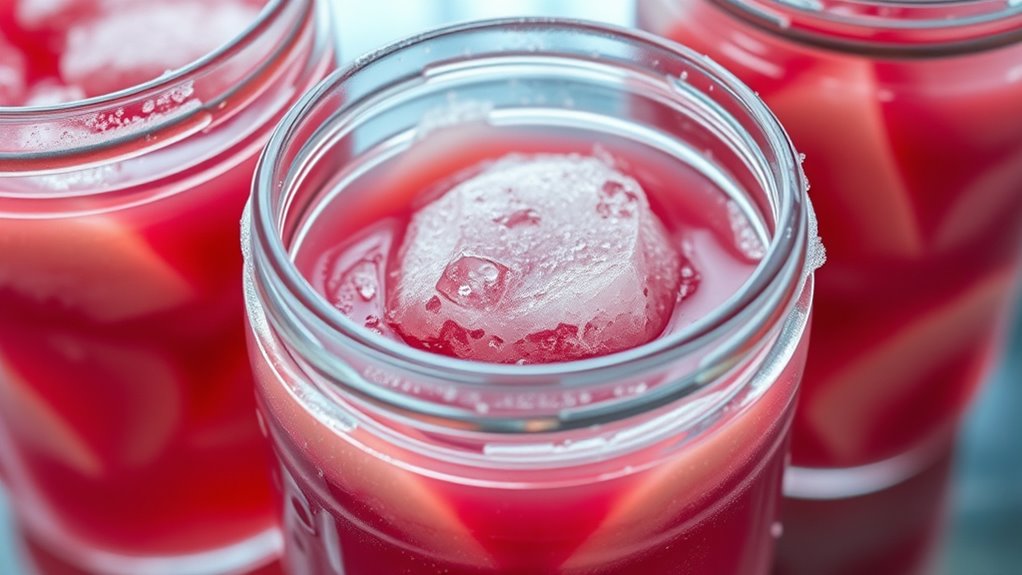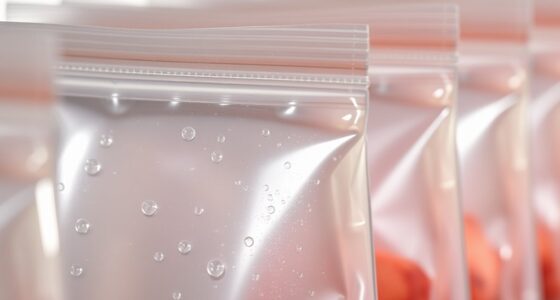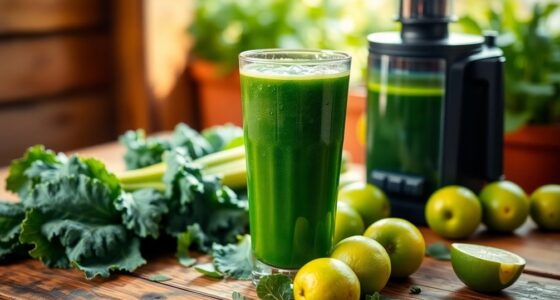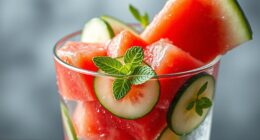When freezing juice, choose sturdy, airtight containers like plastic bottles or glass jars designed for freezing, avoiding thin plastic bags. Leave about half an inch of headspace to allow for expansion during freezing. Use slow thawing in the refrigerator, and stir or shake the juice afterward to remix any separation. Proper container choice and headspace management help keep your juice fresh and safe longer—continue exploring for more tips to perfect your freezing technique.
Key Takeaways
- Use sturdy, freezer-safe containers like plastic bottles or glass jars, avoiding thin plastic bags.
- Leave about half an inch of headspace to allow for juice expansion during freezing.
- Cool juice to room temperature before pouring into containers and label with the freezing date.
- Thaw frozen juice slowly in the refrigerator overnight to preserve flavor and texture.
- Do not refreeze thawed juice to maintain safety and quality.
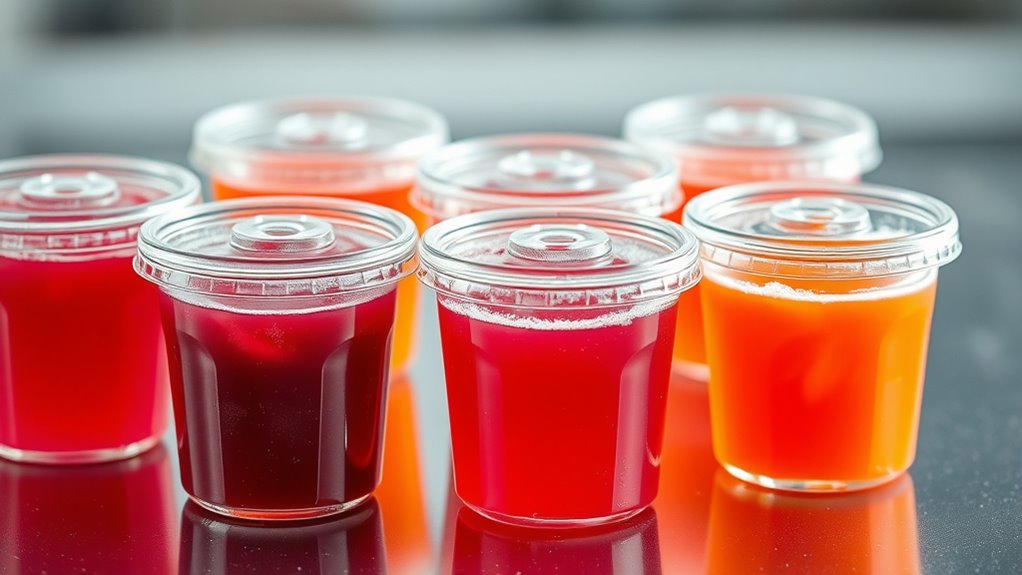
Have you ever wondered if you can freeze juice to extend its shelf life? Freezing is a great way to preserve juice, especially if you’ve bought in bulk or want to hold onto freshly squeezed varieties. The key to successful juice preservation lies in choosing the right container and understanding how to prepare it properly. When selecting containers for freezing juice, you want options that prevent leaks, minimize freezer burn, and allow for safe expansion during freezing. Rigid plastic bottles with secure caps, glass jars designed for freezing, or specialized freezer-safe containers work well. Avoid using thin plastic bags or containers not intended for freezing, as they can crack or leak. The container’s material should be sturdy enough to withstand low temperatures and be airtight to prevent contamination or flavor transfer from other foods in the freezer.
Another important aspect of juice preservation is container selection in relation to how much space you have and how you’ll be thawing the juice later. Leave some headspace—about half an inch—at the top of your container before sealing it. Juice expands as it freezes, and if there’s no room for expansion, the container could crack or burst, leading to messy spills and potential waste. Proper headspace ensures your container can accommodate this expansion safely. If you’re freezing homemade juice, consider portioning it into smaller containers so you can thaw only what you need, reducing waste and maintaining freshness.
Leave about half an inch of headspace to prevent container cracking during freezing.
When it comes to actually freezing your juice, make sure the liquid is cooled to room temperature if it’s freshly squeezed or warm. Pour it into your chosen container, leaving the recommended headspace, and seal it tightly. Label the container with the date to keep track of how long it’s been frozen. Most juices can be safely frozen for up to 8-12 months, but for the best flavor and quality, consume within a few months. Ensuring proper container selection can greatly impact the quality and safety of your frozen juice.
Thawing is just as important as freezing. Transfer the container from the freezer to the refrigerator and allow it to thaw slowly overnight. This method preserves the juice’s flavor and texture better than quick-thawing methods like microwaving or leaving it at room temperature. Once thawed, give the juice a good stir or shake to remix any separation that might have occurred. Avoid refreezing thawed juice, as it can compromise the flavor and safety. Proper container selection, careful headspace management, and gentle thawing are all essential steps to ensure your frozen juice remains delicious and safe to enjoy.
Frequently Asked Questions
How Long Can I Store Frozen Juice Safely?
You can store frozen juice safely for about 8 to 12 months, but quality may decline over time due to juice spoilage. Using proper freezing techniques, like leaving enough headspace in containers, helps prevent spoilage caused by expansion. For best taste, consume your juice within this period. Always label your containers with the date, so you know when to use it and avoid risking spoilage from old, improperly stored juice.
Can I Refreeze Thawed Juice Without Quality Loss?
Refreezing thawed juice is like catching a fragile butterfly—it’s possible but risks damaging its delicate beauty. If you thaw your juice properly using safe thawing methods, you can refreeze it, but expect some quality loss. For safe refreezing, guarantee the juice was kept at proper temperatures. While it’s generally safe, repeated thawing and refreezing may alter taste and texture, so consider consuming it promptly instead.
What Is the Best Way to Thaw Frozen Juice?
The best way to thaw frozen juice is to use slow, safe thawing methods like refrigerator thawing. Place the juice in a leak-proof container, preferably glass or BPA-free plastic, with enough headspace for expansion. Avoid thawing at room temperature to prevent bacteria growth. For quick thawing, submerge the sealed container in cold water, but always consume the juice promptly after thawing to maintain quality.
Does Freezing Affect Juice Flavor or Nutritional Content?
Freezing preserves the essence of your juice like a frozen snapshot, so it generally doesn’t harm flavor or nutrients. While some slight flavor changes might occur, proper freezing techniques help maintain flavor retention and guarantee juice preservation. You won’t lose significant nutritional content if you freeze and thaw carefully. Think of freezing as a time capsule, locking in freshness while still allowing you to enjoy that vibrant taste when you’re ready.
Are There Specific Containers Best Suited for Freezing Juice?
You should choose plastic bottles or glass jars for freezing juice, as they are best suited to handle low temperatures. Use containers with tight-fitting lids to prevent freezer burn and spills. Avoid overfilling, leaving headspace for expansion. Glass jars are ideal if they’re designed for freezing, but plastic bottles are more flexible. Always leave some space at the top before sealing to accommodate expansion during freezing.
Conclusion
As you pull the frozen juice from the freezer, imagine the icy crystal landscape nestled inside its container, waiting to thaw. When you pour it into a glass, sunlight dances on the liquid, hinting at the vibrant flavors stored within. Properly stored, your juice remains a invigorating oasis, ready to quench your thirst on a warm day. With careful freezing and thawing, you bring a burst of cool, fruity sweetness back to life whenever you desire.
Cindy thoroughly researches juicing trends, techniques, and recipes to provide readers with practical advice and inspiration. Her writing style is accessible, engaging, and designed to make complex concepts easy to understand. Cindy’s dedication to promoting the advantages of juicing shines through her work, empowering readers to make positive changes in their lives through the simple act of juicing.

